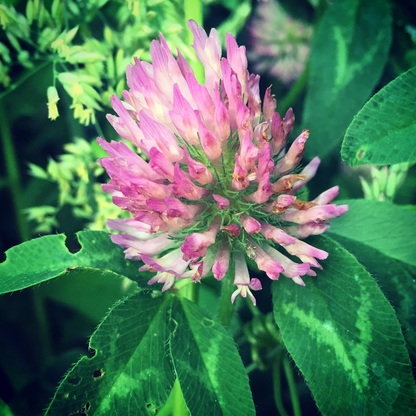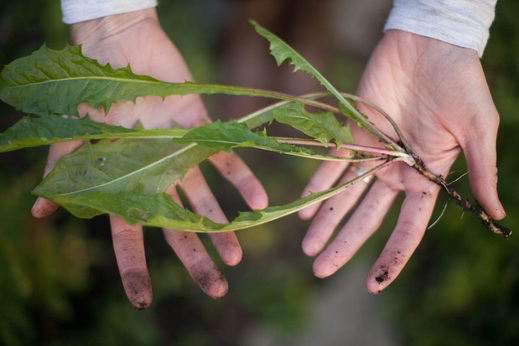 The Rose family (Rosaceae) is one of the most beloved botanical groups; humans have had a deep affinity for these plants for thousands and thousands of years. Not only does this family produce beautiful flowering plants such as spirea, potentilla, lady’s mantle, agrimony and hawthorn, but also important fruit crops such as pears, peaches, plums, cherries, quinces, almonds, raspberries and strawberries. What would our world be like without these delights?! Of all these family members, Rose is the most well-known and sought-after. She is the true queen of flowers. While most people are familiar with the aesthetic and olfactory beauty of the rose, in this country there tends to be less familiarity with the fruit of the rose, i.e. the rosehip. I adore using rosehips this time of year, when the scarlet fruits become full and ripe. All roses will develop hips once their flowers fade, but depending on the species they vary in shape, color, texture and taste. The hip of the dog rose, Rosa canina, is often sold commercially for tea. Around our neck of the woods we are lucky to find Rosa rugosa, the beach rose, which produces the most beautiful, large, tomato-like fruits. Why would we want to use rosehips? First of all, these fruits are a delicious wild edible. They are nutritive and tart, and can be infused into a tea that is high in many vitamins, especially Vitamins A and C. Even though citrus fruits get all the glory for being a great source of Vitamin C, rosehips actually contain a higher concentration of this important vitamin and are in fact one of the richest botanical sources of it. We cannot produce our own Vitamin C so it is essential that we obtain it from food. It is needed for producing hormones, neurotransmitters and hormones in the body. Having plenty of this vitamin in the diet has been correlated with a reduced risk of cancer and cardiovascular disease. In addition, Vitamin C supports the immune system and has been shown to shorten the duration of the common cold. This makes rosehips an excellent addition to fall and winter tea blends. Like other red-hued herbs and fruits -- such as schisandra, hawthorn, and hibiscus -- rosehips are high in bioflavonoids which have an antioxidant action that prevents free radical damage in the body. These bioflavonoids also strengthen heart and blood vessels. Perhaps a lesser known use of rosehips are its effect on the digestive system. The hips are anti-inflammatory and soothing, and thus are useful for hot, inflammatory conditions in the gut such as ulcers, colitis or Crohn’s. They are also a gentle laxative that is traditionally used for mild constipation; the natural pectin content has a beneficial, soothing effect on the intestinal tract. Above all, rosehips are a food. They are commonly harvested to be made into jam and jelly; they can also be baked into pies, used as a thickener for sauces (because of their pectin content), and can even be made into a beautiful soup! (Check out this Swedish rosehip soup recipe I recently discovered…) HOW TO USE ROSEHIPS
 MAKING A ROSEHIP OXYMEL The combination of honey, vinegar and herbs creates an ancient preparation called an oxymel. This simple medicine dates back to the time of the Greeks and has been used for many different ailments, but most especially for digestive and respiratory issues. Today we can make oxymels as a delicious way to preserve our favorite herbs, or to create a medicinal tonic. The simplest method of making an oxymel is to mix together equal parts honey and apple cider vinegar and pour this mixture over your herbs to steep. (Use more vinegar for a thinner oxymel, less vinegar for a more syrup-y oxymel.)
Use this tart honey-vinegar concoction directly by the spoonful, or add to seltzer water for a refreshing drink. You can also use it as the base for sauces, marinades and salad dressings.  Summer is a busy and a beloved time for any herbalist - the plants are out in full force and it is time to garden, grow, harvest, process and preserve the abundance of fresh herbs for use throughout the rest of the year. It is a time that I always eagerly await, but it is also a season that passes very quickly. Many plants have a short window of time that is optimal for harvesting, and even if I plan on collecting certain herbs, sometimes I don’t get to everything on my list. The rhythm of the seasons is an important teacher, and I always keep in mind the line of poetry, “Gather ye rosebuds while ye may, Old Time is still a-flying….” To help you gather your rosebuds and other delightful plants while they are still in their prime, here is a quick list of five of my favorite herbs to collect and use at this time of year. Take a look around your neighborhood and see if you can spot any of these wild or cultivated beauties: Red Clover blooms abundantly throughout the summertime. Look for flowers that are vibrantly colored, and skip those that look wilted or tired. To dry, place the blossoms on a window screen so that airflow can reach all sides of the flower; also make sure the flowers do not touch one another. Use dried red clover blossoms in nourishing tea blends; it mixes well with other herbs like nettles, burdock or dandelion. Calendula is a prolific garden bloomer throughout the whole growing season, hence it’s name, which relates to its ability to flower in every calendar year (if grown in a warm environment). Collect the flower tops when they are freshly opened, and be sure to keep the resin-filled green sepals which surround the petals. Save dried calendula flowers to throw into your fall and winter soups for an immune-supportive addition. Mugwort can be found growing in disturbed areas and along roadsides (but be sure to avoid collecting near traffic-laden roads.) Clip the tall stalks so that you are harvesting the upper third of the plant. The best time to collect mugwort is right before its very tiny flower buds open. Hang a bundle of the stalks upside down to dry. Use mugwort leaves in bedtime teas to stimulate vivid dreams (really!), or blend with herbs like mint, sage and fennel for a nice digestive tea. Mullein is another wild-growing plant, and one of my favorites. I love spotting its fuzzy leaves and tall, majestic stalks throughout the cityscape. Collect the basal leaves from first or second year plants (mullein is a biennial), or patiently collect the lovely yellow flowers as they emerge. The leaves can be dried on a screen or on brown paper bags and used in an old-fashioned steam to support respiratory health. The flowers are traditionally infused in oil to alleviate ear aches. Dandelion leaves can be collected throughout the growing season. As the summer wears on, the leaves will become more and more bitter, but I find them delicious at any time of year. You can either harvest fresh dandelion leaves to dry and use for tea or you can incorporate them into your food. I love to sautee fresh dandy leaves with some onion as a lovely and nutritious side dish. If you are new to harvesting herbs here are a few tips to get you started:
I hope these tips inspire you to do some of your own herb harvesting this season. I’d love to hear what you are collecting - please be in touch! To learn more, consider joining me in one of my upcoming herbal classes. Happy harvesting! Resources: Medicinal Plants and Herbs (Peterson Field Guides) by S. Foster & James A. Duke Edible Wild Plants (Peterson Field Guides) by Lee Allen Peterson A City Herbal by Maida Silverman Edible and Medicinal Plants by Steve Brill Wild Urban Plants of the Northeast by Peter del Tredici |
Categories
All
Archives
January 2022
|






